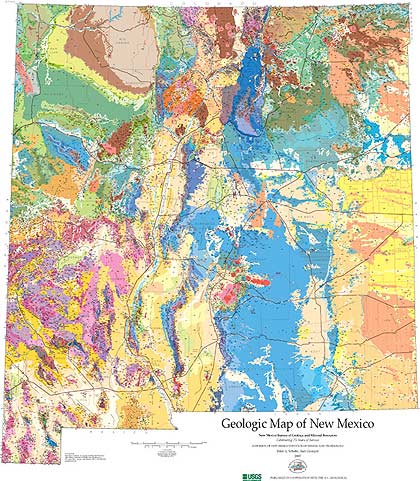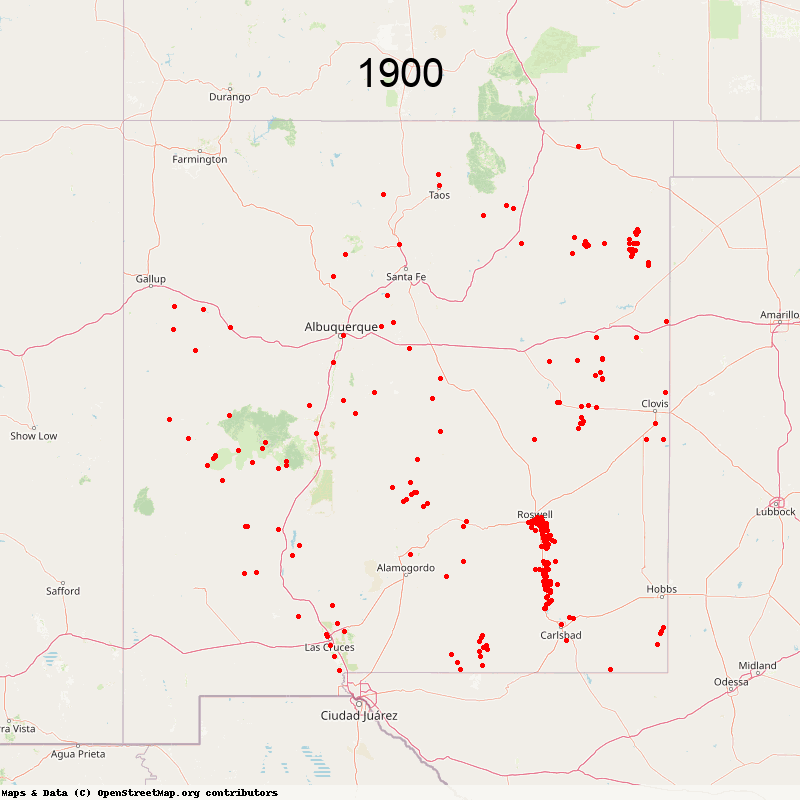Geology, data, and planning for the future of New Mexico’s groundwater
We’ve covered some of the context of the current and projected water realities in New Mexico. Here we’d like to turn our attention to some of the helpful tools (and people) who are supporting effective water planning across the beautiful, arid, complex landscape we call home.
 To the right is New Mexico’s geologic map. It has a beautiful array of colors; blues and pinks, greens and purples, and our fair share of tans, yellows, and browns. When a geologist looks at a map like this, they see a story about the character of the land and how water moves — not just on the surface, but underground, too.
To the right is New Mexico’s geologic map. It has a beautiful array of colors; blues and pinks, greens and purples, and our fair share of tans, yellows, and browns. When a geologist looks at a map like this, they see a story about the character of the land and how water moves — not just on the surface, but underground, too.
Understanding underground water resources is particularly important in a state like ours – where nearly ¾ of household use annually depends on groundwater and the demand for groundwater is growing each year.
Not every state is so colorful. Geologic maps in some places (we’re looking at you Nebraska…) have less complexity. This means their water situation (at least in geologic terms) is more straightforward. New Mexico, as you can see, is a different story. We’re still learning more about what lies under the surface.
So what tools are there to understand groundwater in your area? To find out, we turn to experts Stacy Timmons and Rachel Hobbs at the NM Bureau of Geology & Mineral Resources. Spoiler alert: there are a lot of helpful tools currently available or in the works through the collaborative New Mexico Water Data Initiative.
We’ve covered some of the context of the current and projected water realities in New Mexico. Here we’d like to turn our attention to some of the helpful tools (and people) who are supporting effective water planning across the beautiful, arid, complex landscape we call home.
 Above is New Mexico’s geologic map. It has a beautiful array of colors; blues and pinks, greens and purples, and our fair share of tans, yellows, and browns. When a geologist looks at a map like this, they see a story about the character of the land and how water moves — not just on the surface, but underground, too.
Above is New Mexico’s geologic map. It has a beautiful array of colors; blues and pinks, greens and purples, and our fair share of tans, yellows, and browns. When a geologist looks at a map like this, they see a story about the character of the land and how water moves — not just on the surface, but underground, too.
Understanding underground water resources is particularly important in a state like ours – where nearly ¾ of household use annually depends on groundwater and the demand for groundwater is growing each year.
Not every state is so colorful. Geologic maps in some places (we’re looking at you Nebraska…) have less complexity. This means their water situation (at least in geologic terms) is more straightforward. New Mexico, as you can see, is a different story. We’re still learning more about what lies under the surface.
So what tools are there to understand groundwater in your area? To find out, we turn to experts Stacy Timmons and Rachel Hobbs at the NM Bureau of Geology & Mineral Resources. Spoiler alert: there are a lot of helpful tools currently available or in the works through the collaborative New Mexico Water Data Initiative.
Understanding New Mexico's Water Complexity:
Sustaining life in a desert environment requires a nuanced and delicate balance between how much water we need and how much water is available. But that data hasn’t always been easy to find or easy to understand, especially for those of us who don’t have experience with data analysis (let's be real, that is most of us). That is changing, says Hobbs. "We're working towards a future where anyone, from researchers and policymakers to concerned citizens, can access the data they need to make informed decisions about our water resources." This is happening through The New Mexico Water Data Initiative.
The Water Data Initiative got its start in 2019 with partners that include the New Mexico Bureau of Geology & Mineral Resources, the Office of the State Engineer and Interstate Stream Commission, the New Mexico Environment Department, and the New Mexico Energy, Minerals and Natural Resources Department. Together they are working to consolidate scattered data points into a centralized place for easy and accurate access.
The Initiative recently launched the New Mexico groundwater map, an interactive map that pulls data on groundwater measurements from federal, state, and municipal sources, showing where water levels are going up, staying steady, or declining. This groundwater map, which is still evolving, is a great example of how the Water Data Initiative is streamlining a wealth of information from various sources into an interactive and accessible tool, all in service to effective water planning.
Challenges and the Path Forward:
When it comes to groundwater, both Timmons and Hobbs are sure to note that New Mexico has challenges ahead. Many regions are observing declining water levels due to ongoing use of groundwater and slow recharge from drought conditions. Well drilling technology was nearly non-existent until the late 1940’s, but since that time roughly 2,000 wells have been drilled each year.

So what comes next? Timmons says the initiative is now working on a statewide water quality map. She says, “we want to make water quality data accessible, so no one has to hunt it down from 18 different places.” As the initiative continues, they will be expanding the toolset, following the data needs of water planning efforts across communities in New Mexico.
To learn more about the New Mexico Water Data Initiative and its catalog of data, visit newmexicowaterdata.org.



 To the right is New Mexico’s geologic map. It has a beautiful array of colors; blues and pinks, greens and purples, and our fair share of tans, yellows, and browns. When a geologist looks at a map like this, they see a story about the character of the land and how water moves — not just on the surface, but underground, too.
To the right is New Mexico’s geologic map. It has a beautiful array of colors; blues and pinks, greens and purples, and our fair share of tans, yellows, and browns. When a geologist looks at a map like this, they see a story about the character of the land and how water moves — not just on the surface, but underground, too.